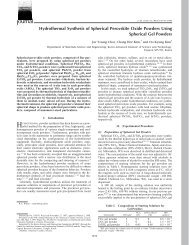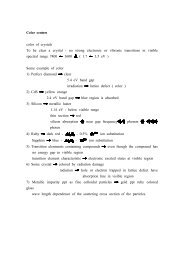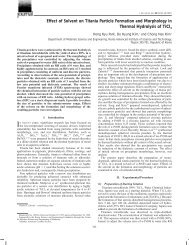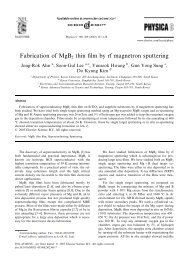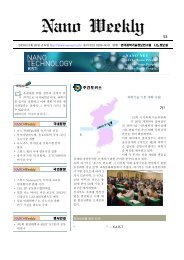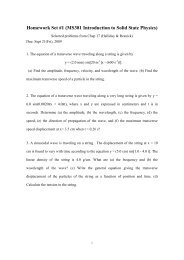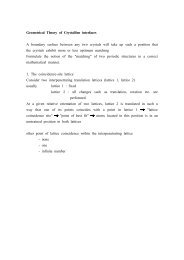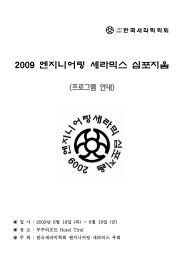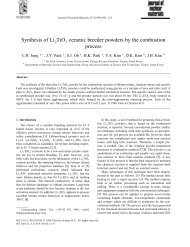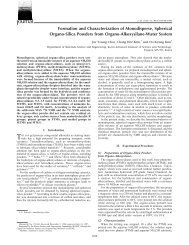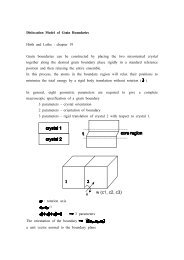Spinel LiMn2O4 Nanorods as Lithium Ion Battery Cathodes
Spinel LiMn2O4 Nanorods as Lithium Ion Battery Cathodes
Spinel LiMn2O4 Nanorods as Lithium Ion Battery Cathodes
Create successful ePaper yourself
Turn your PDF publications into a flip-book with our unique Google optimized e-Paper software.
<strong>Spinel</strong> <strong>LiMn2O4</strong> <strong>Nanorods</strong> <strong>as</strong> <strong>Lithium</strong> <strong>Ion</strong><br />
<strong>Battery</strong> <strong>Cathodes</strong><br />
Do Kyung Kim, † P. Muralidharan, † Hyun-Wook Lee, † Riccardo Ruffo, ‡<br />
Yuan Yang, § Candace K. Chan, | Hailin Peng, § Robert A. Huggins, § and Yi Cui* ,§<br />
Department of Materials Science and Engineering, Korea AdVanced Institute of<br />
Science and Technology (KAIST), Daejeon 305-701, Korea, Dipartimento di Scienza<br />
dei Materiali, UniVersità degli Studi di Milano-Bicocca, Via Cozzi 53,<br />
20135 Milan, Italy, and Department of Materials Science and Engineering,<br />
Department of Chemistry, Stanford UniVersity, Stanford, California 94305<br />
Received August 10, 2008<br />
ABSTRACT<br />
<strong>Spinel</strong> <strong>LiMn2O4</strong> is a low-cost, environmentally friendly, and highly abundant material for Li-ion battery cathodes. Here, we report the hydrothermal<br />
synthesis of single-crystalline -MnO2 nanorods and their chemical conversion into free-standing single-crystalline <strong>LiMn2O4</strong> nanorods using<br />
a simple solid-state reaction. The <strong>LiMn2O4</strong> nanorods have an average diameter of 130 nm and length of 1.2 µm. Galvanostatic battery testing<br />
showed that <strong>LiMn2O4</strong> nanorods have a high charge storage capacity at high power rates compared with commercially available powders. More<br />
than 85% of the initial charge storage capacity w<strong>as</strong> maintained for over 100 cycles. The structural transformation studies showed that the Li<br />
ions intercalated into the cubic ph<strong>as</strong>e of the <strong>LiMn2O4</strong> with a small change of lattice parameter, followed by the coexistence of two nearly<br />
identical cubic ph<strong>as</strong>es in the potential range of 3.5 to 4.3V.<br />
<strong>Lithium</strong> ion batteries with high energy and power density<br />
are important for consumer electronic devices, portable power<br />
tools, and vehicle electrification. 1-4 LixCoO2 is a commonly<br />
used cathode material in commercial lithium ion batteries<br />
and h<strong>as</strong> a charge capacity of 140 mAh/g with a practical<br />
value of x from 0.5 to 1. However, the high cost, toxicity,<br />
and limited abundance of cobalt have been recognized to be<br />
disadvantageous. As a result, alternative cathode materials<br />
have attracted much interest. One promising candidate is<br />
spinel <strong>LiMn2O4</strong>, which h<strong>as</strong> a charge storage capacity of 148<br />
mAh/g. 5-9 <strong>Spinel</strong> <strong>LiMn2O4</strong> h<strong>as</strong> the advantages of low-cost,<br />
environmental friendliness, and high abundance.<br />
Nanostructuring battery electrode materials have been<br />
shown to enhance power performance due to the large<br />
surface-to-volumeratiothatallowsforalargeelectrode-electrolyte<br />
contact area. 10-16 Nanowires or nanorods are particularly<br />
attractive. Recently we have demonstrated examples of using<br />
Si and Ge nanowires <strong>as</strong> ultrahigh capacity anode materials.<br />
17,18 The nanowire or nanorod morphology not only h<strong>as</strong><br />
a large surface-to-volume ratio but also provides efficient<br />
one-dimensional electron transport pathways and facile strain<br />
relaxation during battery charge and discharge.<br />
* To whom correspondence should be addressed. E-mail: yicui@<br />
stanford.edu.<br />
† Korea Advanced Institute of Science and Technology (KAIST).<br />
‡ Università degli Studi di Milano-Bicocca.<br />
§ Department of Materials Science and Engineering, Stanford University.<br />
| Department of Chemistry, Stanford University.<br />
10.1021/nl8024328 CCC: $40.75 © 2008 American Chemical Society<br />
Published on Web 10/01/2008<br />
NANO<br />
LETTERS<br />
2008<br />
Vol. 8, No. 11<br />
3948-3952<br />
A wide variety of synthetic approaches have been<br />
developed for the synthesis of <strong>LiMn2O4</strong> nanoparticles,<br />
including combustion, 19,20 sol-gel, 21 solution-ph<strong>as</strong>e, 22 and<br />
templating 11 methods. Aggregated <strong>LiMn2O4</strong> nanorods have<br />
also been produced <strong>as</strong> cathodes. 23 A facile method is to<br />
chemically convert -MnO2 nanorods into <strong>LiMn2O4</strong>. Here<br />
we report the hydrothermal synthesis of single-crystalline<br />
-MnO2 nanorods and their chemical conversion into freestanding<br />
single-crystalline <strong>LiMn2O4</strong> nanorods in a simple<br />
solid-state reaction. <strong>Battery</strong> testing showed that <strong>LiMn2O4</strong><br />
nanorods have a high charge storage capacity at high power<br />
operation, which is significantly better than the commercially<br />
available powders with particle sizes around 10 µm. More<br />
than 85% of the initial charge storage capacity is maintained<br />
for over 100 cycles. The structural transformation studies<br />
showed that the Li ions intercalated into the cubic ph<strong>as</strong>e of<br />
the <strong>LiMn2O4</strong> with a small change of lattice parameter,<br />
followed by the coexistence of two nearly identical cubic<br />
ph<strong>as</strong>es in the potential range of 3.5 to 4.3 V.<br />
Experiments. Synthesis of MnO2 and <strong>LiMn2O4</strong> <strong>Nanorods</strong>.<br />
Analytical grade Mn(CH3COO)2·4H2O, Na2S2O8 (99.99%<br />
Aldrich), and deionized water were used to prepare -MnO2<br />
nanorods by hydrothermal reaction <strong>as</strong> reported elsewhere. 24<br />
All chemicals were used without further purification. In a<br />
typical synthesis, Mn(CH3COO)2·4H2O and Na2S2O8 were<br />
dissolved at room temperature with a molar ratio of 1:1 in<br />
80 mL of distilled water by magnetic stirring to form a



